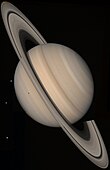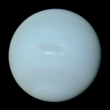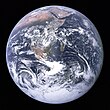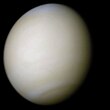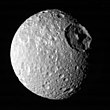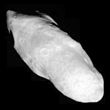ប្រព័ន្ធព្រះអាទិត្យ
 | |
| អាយុកាល | ៤,៥៦៨ អរពៈ (រយកោដិ ឬ សតកោដិ) ឆ្នាំ |
|---|---|
| តំណាំងទី | |
| ដុលប្រព័ន្ធ | ដុលសុរិយា ១,០០១៤ |
| ផ្កាយជិតបំផុត |
|
| ប្រព័ន្ធភព ជិតបំផុតដែលគេស្គាល់ | ប្រព័ន្ធអាល់ផ្វាធនុឞ (៤,៣៧ ឆ.ព.) |
| ប្រព័ន្ធភព | |
| កន្លះអ័ក្សធំនៃភព ខាងក្រៅ (កេតុ) | ៣០,១០ ខ.ត. (៤,៥០៣ អរពៈ គម.) |
| ចម្ងាយពីចំណោតខៃផឺរ | ៥០ ខ.ត. |
ជំរឿន | |
| ផ្កាយ | ១ (ព្រះអាទិត្យ) |
| ភព | |
| ភពក្រិនដែលគេស្គាល់ | |
| ភពរណបដែលគេស្គាល់ | |
| Known minor planets | 659,212 (as of 2014-09-25)[៤] |
| Known comets | 3,296 (as of 2014-09-25)[៤] |
| Identified rounded satellites | 19 |
| Orbit about Galactic Center | |
| Invariable-to-galactic plane inclination | 60.19° (ecliptic) |
| Distance to Galactic Center | 27,000 ± 1,000 ly |
| Orbital speed | 220 km/s |
| Orbital period | 225–250 Myr |
| Star-related properties | |
| Spectral type | G2V |
| Frost line | ≈5 AU[៥] |
| Distance to heliopause | ≈120 AU |
| Hill sphere radius | ≈1–2 ly |
| Objects in the Solar System |
|---|
| Categories |
ប្រព័ន្ធព្រះអាទិត្យ ឬ ប្រព័ន្ធសុរិយចក្រវាឡ ឬ សូរ្យព័ន្ធចក្រ[៦] មានព្រះអាទិត្យ និងវត្ថុ ដែលគន្លងជុំវិញវា ដោយផ្ទាល់ឬ ដោយប្រយោល។[៧] ទាំងវត្ថុនោះដែលគន្លងជុំវិញ ព្រះអាទិត្យដោយផ្ទាល់ វត្ថុធំជាងគេគឺជាភពចំនួន ប្រាំបីអង្គ[៨] ដែលបង្កើតប្រព័ន្ធភពនៅជុំវា ខណៈវត្ថុសល់គឺ វត្ថុតចៗយ៉ាងខ្លាំងដូចជា៖ កូនភព និង សាកសពតូចនៃប្រពន្ធព្រះអាទិត្យ (ស.ត.ប.ព.) ដូច ផ្កាយដុះកន្ទុយ និង អាចម៍ផ្កាយ[១៣]
ប្រព័ន្ធព្រះអាទិត្យបានបង្កើតឡើង ៤,៦ ពាន់លានឆ្នាំមុន ពីការដួលរលំទំនាញ របស់ពពកម៉ូលេគុល អន្តរតារាយក្សមួយ។ ភាគច្រើននៃ ម៉ាស់របស់ប្រព័ន្ធ គឺស្ថិតនៅក្នុង ព្រះអាទិត្យ និង ម៉ាស់នៅសល់ដែលមានច្រើនជាងគេបន្ទាប់ ស្ថិតក្នុង ភពព្រហស្បតិ៍។ ភពតូចខាងក្នុងទាំង បួនអង្គ ពុធ, សុក្រ, ផែនដី និង អង្គារ ក៏ហៅថា ភពដី គឺត្រូវបានផ្សំភាកច្រើនពី ថ្មនិងដែក។ ភពខាងក្រៅធំចម្បងហៅថា ភពយក្ស គឺធំជាងភពដីយ៉ាងខ្លាំង។ ភពពីរធំជាងគេ ឧស្ម័នយក្យ ព្រហស្បតិ៍ និង សៅរ៍គឺត្រូវបង្កើតពី អ៊ីដ្រូសែន និង អេលីយ៉ូម : ភពខាងក្រៅបំផុត ពីរអង្គ ទឹកកកយក្ស Uranus និង ណិបទូន គឺកើតមកពីសារធាតុដែលមានចំណុចរលាយខ្ពស់ បើធៀបនឹង អ៊ីដ្រូសែន និង អេលីយ៉ូមហៅថា ធាតុទឹកកក ដូចជាទឹក អាម៉ូញាក់ និង មេតេន។ All planets have almost circular orbits that lie within a nearly flat disc called the ecliptic.
នៅពាក់កណ្ដាលឆ្នាំ ២០០៨ អង្គធាតុតូចៗបួន ត្រូវបានគេចាត់ចូលក្នុងថ្នាក់ កូនភព (dwarfplanets) ។ កូនភព ទាំងបួននោះគឺ៖ សឺរេស (Ceres) ស្ថិតនៅក្នុងខ្សែក្រវាត់ផ្កាយព្រះគ្រោះ និងកូនភពបីទៀតមាន ភ្លុយតុង (Pluto) (នព្វគ្រោះ) ម៉ាគីម៉ាគី (Makemake) និង អៀរីស (Eris) ដែលគោចរជុំវិញព្រះអាទិត្យ នៅក្រៅភពណិបទូន
ផ្កាយព្រះគ្រោះ រិសថា (Vesta)។
ភពចំនួនប្រាំមួយ និងកូនភពពីរទៀត ត្រូវបានវិលជុំវិញដោយតារារណបធម្មជាតិ ដែលគេឱ្យឈ្មោះថា ព្រះចន្ទ (Moons) បន្ទាប់ពី ព្រះចន្ទរបស់ផែនដី ព្រះចន្ទនៃភពខាងក្រៅ ត្រូវបានហ៊ុមព័ន្ធជុំវិញជារង្វង់ ដោយធូលី និងភាគល្អិតផ្សេងទៀត។
The Solar System formed 4.6 billion years ago from the gravitational collapse of a giant molecular cloud. The vast majority of the system's mass is in the Sun, with most of the remaining mass contained in Jupiter. The four smaller inner planets, Mercury, Venus, Earth and Mars, also called the terrestrial planets, are primarily composed of rock and metal. The four outer planets, called the gas giants, are substantially more massive than the terrestrials. The two largest, Jupiter and Saturn, are composed mainly of hydrogen and helium; the two outermost planets, Uranus and Neptune, are composed largely of substances with relatively high melting points (compared with hydrogen and helium), called ices, such as water, ammonia and methane, and are often referred to separately as "ice giants". All planets have almost circular orbits that lie within a nearly flat disc called the ecliptic plane.
The Solar System also contains regions populated by smaller objects.[lower-alpha ១] The asteroid belt, which lies between Mars and Jupiter, mostly contains objects composed, like the terrestrial planets, of rock and metal. Beyond Neptune's orbit lie the Kuiper belt and scattered disc, linked populations of trans-Neptunian objects composed mostly of ices. Within these populations are several dozen to more than ten thousand objects that may be large enough to have been rounded by their own gravity.[១៤] Such objects are referred to as dwarf planets. Identified dwarf planets include the asteroid Ceres and the trans-Neptunian objects Pluto and Eris.[lower-alpha ១] In addition to these two regions, various other small-body populations, including comets, centaurs and interplanetary dust, freely travel between regions. Six of the planets, at least three of the dwarf planets, and many of the smaller bodies are orbited by natural satellites,[lower-alpha ២] usually termed "moons" after Earth's Moon. Each of the outer planets is encircled by planetary rings of dust and other small objects.
The solar wind, a flow of plasma from the Sun, creates a bubble in the interstellar medium known as the heliosphere, which extends out to the edge of the scattered disc. The Oort cloud, which is believed to be the source for long-period comets, may also exist at a distance roughly a thousand times further than the heliosphere. The heliopause is the point at which pressure from the solar wind is equal to the opposing pressure of interstellar wind. The Solar System is located in the Orion Arm, 26,000 light years from the center of the Milky Way.
យត្តស័ព្ទ
[កែប្រែ]
មណ្ឌល
[កែប្រែ]តាមធម្មតា គេចែកប្រព័ន្ធព្រះអាទិត្យ ទៅជាមណ្ឌល។ មណ្ឌលខាងក្នុងនៃប្រព័ន្ធព្រះអាទិត្យ រួមបញ្ចូលភពរឹងបួន និងខ្សែក្រវាត់ផ្កាយព្រះគ្រោះ ហើយមណ្ឌលខាងក្រៅ សំដៅលើអ្វីទាំងអស់ ដែលស្ថិតនៅក្រៅខ្សែក្រវាត់ផ្កាយព្រះគ្រោះ។ ចាប់តាំងពីការរកឃើញខ្សែក្រវាត់ខាយព័រនៅក្រៅ ភពណិបទូន គេបានកំណត់យកភពឧស្ម័នយក្សទាំងបួនជាមណ្ឌលកណ្ដាល។
ភព កូនភព និងរូបធាតុតូចៗ
[កែប្រែ]នៅខែសីហា ២០០៦ សហភាពតារាសាស្ត្រអន្តរជាតិ (International Astronomical Union) បានកំណត់និយមន័យនៃភព ជាដំបូង ដោយសារការរកឃើញចក្រវាលថ្មីមួយទៀតឈ្មោះ អៀរីស ហើយការពិភាក្សាជាបន្តបន្ទាប់ គឺស្ដីពីការចាត់ថ្នាក់របស់វា។ តាមនិយមន័យនេះ គេបានចែកវត្ថុធាតុ ដែលគោចរជុំវិញព្រះអាទិត្យ ជាបីថ្នាក់ផ្សេងគ្នាគឺ៖ ភព កូនភព និងរូបធាតុតូចៗនៃប្រព័ន្ធព្រះអាទិត្យ។
ភពគឺជាអង្គធាតុទាំងឡាយណា ដែលគោចរជុំវិញព្រះអាទិត្យ មានម៉ាសគ្រប់គ្រាន់ ដើម្បីឱ្យខ្លួនវាមានរាងជាស្វ៊ែរ ហើយអាចសម្អាតវត្ថុតូចៗដែលស្ថិតនៅជិតគន្លងគោចររបស់ខ្លួន។ ដោយផ្អែកតាមនិយមន័យនេះ ប្រព័ន្ធព្រះអាទិត្យ មានភពចំនួនប្រាំបី ដែលត្រូវបានគេស្គាល់គឺ៖ ភពពុធ ភពសុក្រ ភពផែនដី ភពអង្គារ ភពព្រហស្បតិ៍ ភពសៅរ៍ ភពអ៊ុយរ៉ានុស និងភពណិបទូន។ ភ្លុយតុង ត្រូវបានបាត់បង់ឋានៈជាភព ដោយសារតែវាមិនបានសម្អាតវត្ថុធាតុផ្សេងក្នុងខ្សែក្រវាត់ខាយព័រ ដែលស្ថិតនៅជិតគន្លងរបស់ខ្លួនឡើយ។
កូនភពគឺជាអង្គធាតុទាំងឡាយណា ដែលគោចរជុំវិញព្រះអាទិត្យ មានម៉ាសធំគ្រប់គ្រាន់ធៀបនឹងវត្ថុនៅជុំវិញដោយទំនាញរបស់វា តែមិនអាចសម្អាតវត្ថុធាតុផ្សេងដែលនៅជិតគន្លងរបស់ខ្លួនបាន ដូចភពឡើយ និងពុំមែនជាតារារណប។ តាមនិយមន័យនេះ ក្នុងប្រព័ន្ធព្រះអាទិត្យ មានកូនភពចំនួនបួន ដែលត្រូវបានគេស្គាល់គឺ៖ សឺរេស ភ្លុយតុង ម៉េកម៉េក និងអៀរីស។ អង្គធាតុផ្សេងទៀត ទំនងជាអាចចាត់ចូលទៅក្នុងថ្នាក់ជាកូនភពដែរនោះមាន៖ សេដណា (Sedna) អ៊រគុស (Orcus) និង កៅអា (Quaoar) ។ កូនភព ដែលវិលជុំវិញ មណ្ឌលត្រង់-ណិបទូនាន (the trans-Neptunian) ហៅថា ភ្លុយតូអ៊ីដ (Plutoids) ។
ក្រៅពីនេះ អង្គធាតុដទៃទៀតដែលវិញជុំវិញព្រះអាទិត្យ ហៅថា រូបធាតុតូចៗនៃប្រព័ន្ធព្រះអាទិត្យ។
ឧស្ម័ន ថ្ម និងទឹកកក
[កែប្រែ]តារាវិទូជាច្រើន បានកំណត់ពាក្យស័ព្ទ៖ ឧស្ម័ន ថ្ម និង ទឹកកក ដើម្បីពណ៌នាថ្នាក់នៃវត្ថុធាតុជាច្រើន ដែលបានរកឃើញនៅក្នុងលំហ។ ឧស្ម័ន គឺជារូបធាតុដែលចំណុចរលាយទាប ដូចជា៖ អាតូមអ៊ីដ្រូសែន (H) អេល្យូម (He) និង ឧស្ម័នកម្រ (Noble) ។ ទឹកកក មានដូចជា៖ ទឹក (H2O: water) មេតាន (CH4: methane) អាម៉ូញ៉ាក់ (NH3: ammonia) និង កាបូនឌីអុកស៊ីត (CO2: carbon dioxide) ដែលមានចំណុចរលាយរហូតដល់ ២00-៣00 អង្សាកែវិន (Kevin) ។ ការផ្លាស់ប្ដូរថ្នាក់ពាក្យស័ព្ទ ទាំងនេះតាងដោយការប្រមូលផ្ដុំសារធាតុ ដែលមានចំណុចរំពុះទាប (ក្រោម ២០០-៣០០ អង្សាកែវិន) រួមមាន ទឹកកក និង ឧស្ម័ន អាស្រ័យទៅនឹងសីតុណ្ហភាព។ ការផ្លាស់ប្ដូរនេះ អាចជា ទឹកកក វត្ថុរាវ និង ឧស្ម័ន ដែលត្រូវបានគេប្រទះនៅកន្លែងជាច្រើននៃប្រព័ន្ធព្រះអាទិត្យ។ ថ្ម (rock) ត្រូវបានគេប្រើដើម្បី ពណ៌នាពីរូបធាតុ ដែលមានចំណុចរលាយខ្ពស់ (លើសពី ៥០០ អង្សាកែវិន) ដែលជាធាតុផ្សំច្រើនបំផុតនៃភពរឹង ដូចជាស៊ីលីកាត (Si2O: silicates) ជាដើម។
ខ្នាតតារាសាស្ត្រ (Astronomical unit)
[កែប្រែ]តារាវិទូ តែងតែវាស់ចម្ងាយដែលស្ថិតនៅក្នុងប្រព័ន្ធព្រះអាទិត្យ ដោយគិតជាខ្នាតតារាសាស្ត្រ (AU) ។ ១ ខ្នាតតារាសាស្ត្រ គឺកំណត់យកចម្ងាយមធ្យមពីផែនដីទៅព្រះអាទិត្យ ដោយ 1 AU = 149,598,000 km (92,956,000 mi) ។ ភ្លុយតុង មានចម្ងាយប្រហែល 38 AU ពីព្រះអាទិត្យ ខណៈដែល ភពព្រហស្បតិ៍ មានចម្ងាយ 5.2 AU ។ មួយឆ្នាំពន្លឺ (light-year) មាន 63,240 AU ។
ព្រះអាទិត្យ
[កែប្រែ]
មណ្ឌលខាងក្នុង
[កែប្រែ]ភពក្នុង
[កែប្រែ]ខ្សែក្រវាត់ផ្កាយព្រះគ្រោះ
[កែប្រែ].1......%
មណ្ឌលកណ្ដាល
[កែប្រែ]ភពក្រៅ
[កែប្រែ]ផ្កាយដុះកន្ទុយ
[កែប្រែ]សង្ខេបជារូបភាព
[កែប្រែ]Visual summary
[កែប្រែ]A sampling of closely imaged solar system bodies, selected for size and detail. See also List of Solar System objects by size, List of natural satellites, List of minor planets, and Lists of comets. Images here are not an endorsement of natural color in visible light.
See also
[កែប្រែ]- Astronomical symbols
- List of gravitationally rounded objects of the Solar System
- List of geological features of the Solar System
- Planetary mnemonic
- Solar System in fiction
Notes
[កែប្រែ]- ↑ ១,០ ១,១ Cite error: Invalid
<ref>tag; no text was provided for refs namedfootnoteB - ↑ See List of natural satellites of the Solar System for the full list of natural satellites of the eight planets and first five dwarf planets.
References
[កែប្រែ]- ↑ Mike Brown (August 23, 2011). "Free the dwarf planets!". "Mike Brown's Planets (self-published)".
- ↑ Sheppard, Scott S. "The Giant Planet Satellite and Moon Page". Departament of Terrestrial Magnetism at Carniege Institution for science. Retrieved 2014-09-25.
- ↑ Wm. Robert Johnston (2014-09-20). "Asteroids with Satellites". Johnston's Archive. Retrieved 2014-09-25.
- ↑ ៤,០ ៤,១ "How Many Solar System Bodies". NASA/JPL Solar System Dynamics. Retrieved 2014-09-25.
- ↑ doi:10.1016/S0273-1177(03)00578-7
This citation will be automatically completed in the next few minutes. You can jump the queue or expand by hand - ↑ Capitalization of the name varies. The IAU, the authoritative body regarding astronomical nomenclature, specifies capitalizing the names of all individual astronomical objects ("Solar System"). However, the name is commonly rendered in lower case ("solar system"), as, for example, in the Oxford English Dictionary and Merriam-Webster's 11th Collegiate Dictionary.
- ↑ The moons orbiting the Solar System's planets are an example of the latter.
- ↑ Historically, several other bodies were once considered planets, including, from its discovery in 1930 until 2006, Pluto. See Former planets.
- ↑ ៩,០ ៩,១ ៩,២ "The Final IAU Resolution on the definition of "planet" ready for voting". IAU. 2006-08-24. http://www.iau.org/iau0602.423.0.html។ បានយកមក 2007-03-02.
- ↑ "Dwarf Planets and their Systems". Working Group for Planetary System Nomenclature (WGPSN). U.S. Geological Survey. 2008-11-07. Retrieved 2008-07-13.
- ↑ Ron Ekers. "IAU Planet Definition Committee". International Astronomical Union. Archived from the original on 2009-06-03. Retrieved 2008-10-13.
- ↑ "Plutoid chosen as name for Solar System objects like Pluto". International Astronomical Union, Paris. June 11, 2008. http://www.iau.org/news/pressreleases/detail/iau0804/។ បានយកមក 2008-06-11.
- ↑ According to current definitions, objects in orbit around the Sun are classified dynamically and physically into three categories: planets, dwarf planets, and small Solar System bodies.
A planet is any body in orbit around the Sun whose mass is sufficient for gravity to have pulled it into a (near-)spherical shape and which has cleared its immediate neighbourhood of all smaller objects. By this definition, the Solar System has eight planets: Mercury, Venus, Earth, Mars, Jupiter, Saturn, Uranus, and Neptune. As it has not cleared its neighbourhood of other Kuiper belt objects, Pluto does not fit this definition.[៩]
Instead, Pluto is considered to be a dwarf planet, a body orbiting the Sun that is massive enough to be made near-spherical by its own gravity but which has not cleared planetesimals from its neighbourhood and is also not a satellite.[៩] In addition to Pluto, the IAU has recognized four other dwarf planets in the Solar System: Ceres, Haumea, Makemake, and Eris.[១០] Other objects commonly (but not officially) treated as dwarf planets include ទំព័រគំរូ:Mpl, Sedna, Orcus, and Quaoar.[១១] In a reference to Pluto, other dwarf planets orbiting in the trans-Neptunian region are sometimes called "plutoids".[១២]
The remaining objects in orbit around the Sun are known as small Solar System bodies.[៩] - ↑ "Today we know of more than a dozen dwarf planets in the solar system".The PI's Perspective Archived 2014-11-13 at the វេយប៊ែខ ម៉ាស៊ីន.
External links
[កែប្រែ]| ស្វែងយល់បន្ថែមអំពីSolar Systemលើ គម្រោងបងប្អូនរបស់វិគីភីឌា: | |
| និយមន័យនិងបំណកប្រែពីវិគីនានុក្រម | |
| រូបភាពនិងមីឌាពី Wikimedia Commons | |
| ប្រភពរៀនសូត្រពីវិគីសាកលវិទ្យាល័យ | |
| រឿងរ៉ាវព័ត៌មានពីវិគីព័ត៌មាន | |
| សម្រង់ពាក្យសម្ដីពីវិគីសម្រង់ពាក្យ | |
| អត្ថបទប្រភពដើមពីវិគីប្រភព | |
| សៀវភៅពុម្ពពីវិគីសៀវភៅ | |
- Solar System Profile by NASA's Solar System Exploration
- NASA's Solar System Simulator
- NASA/JPL Solar System main page
ទំព័រគំរូ:Nearest systems ទំព័រគំរូ:Earth's location ទំព័រគំរូ:Systems
| ប្រព័ន្ធព្រះអាទិត្យ | |||||||
|---|---|---|---|---|---|---|---|
| ព្រះអាទិត្យ • Heliosphere |
ភព ☾ = moon(s) ∅ = rings |
ភពព្រះពុធ | ភពសុក្រ | ភពផែនដី ☾ | ភពអង្គារ ☾ | ||
| ភពព្រហស្បតិ៍ ☾ ∅ | ភពសៅរ៍ ☾ ∅ | ភពអ៊ុយរ៉ានុស ☾ ∅ | ភពណិបទូន ☾ ∅ | ||||
| កូនភព | សឺរេស | ភ្លុយតុង ☾ | ហូមា ☾ | ម៉ាគីម៉ាគី | |||
| អៀរីស ☾ | |||||||
| Small Solar System bodies |
Asteroids (minor planets) |
Groups and families: Vulcanoids · Near-Earth asteroids · Asteroid belt Jupiter Trojans · Centaurs · Neptune Trojans · Asteroid moons · Meteoroids · Pallas · Juno · Vesta · Hygiea · | |||||
| See also the list of asteroids. | |||||||
| Trans- Neptunians |
Kuiper belt – Plutinos: Orcus · Ixion – Cubewanos: Varuna · Quaoar · Huya | ||||||
| Scattered disc: Sedna | |||||||
| Comets | Periodic comets and non-periodic comets Damocloids · Oort cloud | ||||||
| See also the list of solar system objects | |||||||


